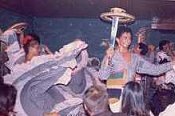
Colombia is located in the north-west corner of South America. Because of its geographical position, many immigrants from all around the globe have passed by, bringing and leaving behind many of their cultural traditions, music and costumes. Groups which have had an influence on music dance and traditions include the various local indigenous peoples, the Spanish conquistadores - Spaniards who came to administrate in the name of their king, and, later, African, French, British, German and Dutch people.
Colombia is divided into five geographical regions: the Atlantic region, the Pacific, Andina (where the Andes are), Llanos Orientales (flat extensive plains for cattle breeding and adventurous cowboys) and, finally, the Amazon which makes up half of the territory and is where most of the remaining indigenous people still live.
In terms of music and dance, the variety of rhythms and dances are put together using the region's names, as peoples' behaviour and attitudes are different according to where they live. Some sociologists argue that these differences are due to such influences as the weather, life style, food and education.
It is true that musical instruments are different in each region, and dances and costumes vary according to the demands of the weather. For example, on the Atlantic coast, a light, bright and airy shirt or blouse might be worn while for the people living in the Andes at more than 2,700 metres above the sea level, a woollen poncho known as a ruana is more appropriate.

 The most representative dance and rhythm from the Colombian Atlantic Region is Cumbia, a smooth and gentle dance performed during carnival time. It is a dance done near the beach with checked, bright-coloured, long dresses for the ladies and white top and trousers for the men with a red scarf and a sombrero vueltiao (which folds away like a panama hat). Ladies usually carry a fire torch which is used to keep men away from them, and the men keep flirting to be able to get closer and closer. Other popular dances not known much abroad from this region are: Mapale, Cumbion, Porro, Seresese, Vallenato, and many more.
The most representative dance and rhythm from the Colombian Atlantic Region is Cumbia, a smooth and gentle dance performed during carnival time. It is a dance done near the beach with checked, bright-coloured, long dresses for the ladies and white top and trousers for the men with a red scarf and a sombrero vueltiao (which folds away like a panama hat). Ladies usually carry a fire torch which is used to keep men away from them, and the men keep flirting to be able to get closer and closer. Other popular dances not known much abroad from this region are: Mapale, Cumbion, Porro, Seresese, Vallenato, and many more.
The Andina Region has, again, an incalculable number of dances as a result of being a central meeting point for many generations and cultures. The most representative would be the Bambuco which would identify the area in general. However, in more detail, there would be other typical dances like Pasillo from Bogota (the capital city), El Torbellino, El Tres and La Guavina from Santander and Boyaca (two of the states within the region). Further south, near to the Ecuadorian border, are La Guaneņa, El San Juanito, El San Juanero and all the varieties of it which are performed and judged every year in the Tolima Grande (two more states called nowadays Tolima and Huila) festivities between June and July.
The Llanos Orientales (the west plain lands) are located between Colombia and Venezuela. Some dances and rhythms such as Joropo, which involves careful foot work, are derived from Spanish Flamenco. Other dances are; Pasaje Llanero and Contrapunteo,. all of them danced with the electrifying music done with the Capachos (maracas), Cuatro (four-stringed instrument which looks like a guitar) and the harp.
In the Pacific you would be able to see, dance and feel the well known salsa, where it is said that here that, "you do not eat salsa, you dance to it". There also dances like Currulao, Peregoyo, Abosado, Tamborito and Jota.
In the Amazons there are dances from different indigenous tribes for purposes such as thanks to the Gods, for the harvest, fishing, puberty and shamanic ritual dances.
You are visitor number
This page hosted by
![]()
Get your own Free Home Page